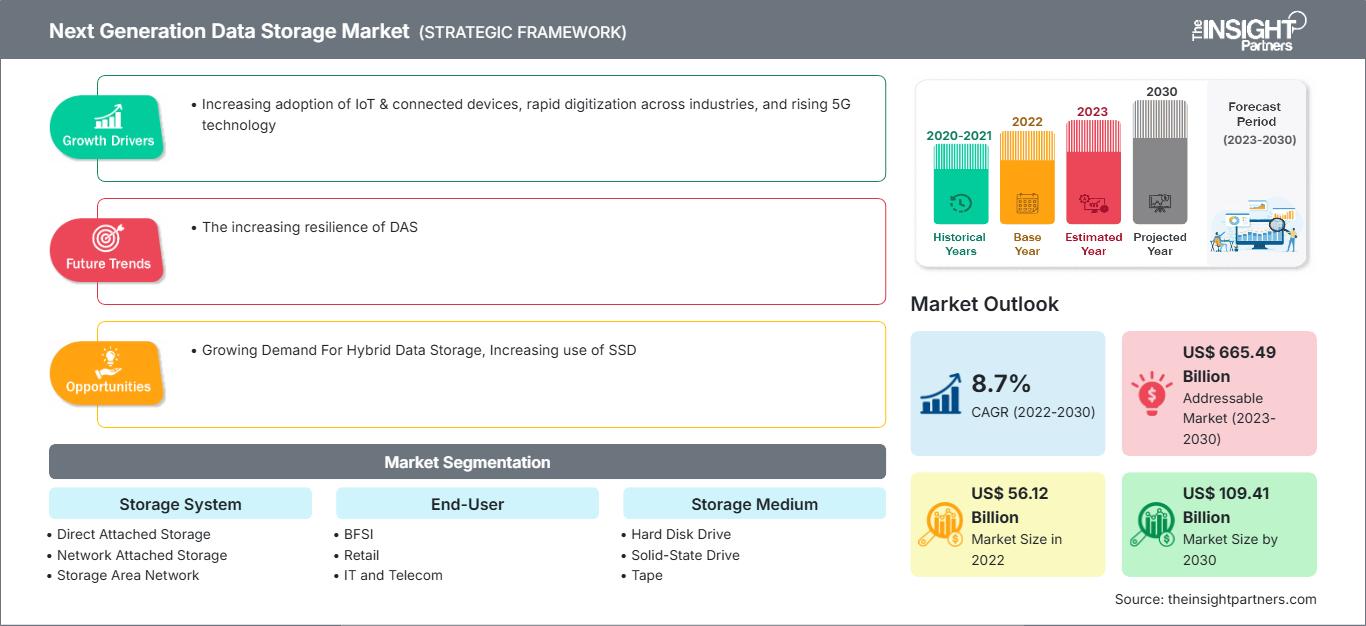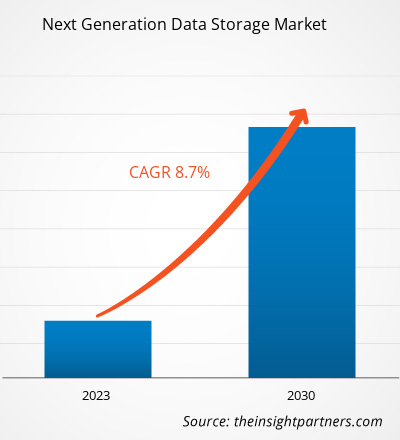下一代数据存储市场规模预计将从 2022 年的 561.2 亿美元增至 2030 年的 1094.1 亿美元;预计 2022 年至 2030 年的复合年增长率为 8.7%。DAS 的不断增强的弹性很可能仍将是市场的主要趋势。
下一代数据存储市场分析
由于技术的不断进步、快速的城市化以及数据存储解决方案提供商对研发的投入不断增加,亚太地区的下一代数据存储市场正在经历显著增长。一个值得注意的发展是亚太数据中心协会 (APDCA) 的成立,这是该地区首个此类协会。APDCA 旨在巩固整个亚太地区数据中心行业的共同利益,将数据中心运营商、供应商和利益相关者聚集在一起。该协会支持倡导鼓励数据中心行业可持续发展的政策。 APDCA 的成立标志着亚太地区数据中心行业共同利益的统一努力。该联盟的成立,以及技术的进步和不断增长的市场需求,彰显了该地区致力于塑造下一代数据存储未来的决心。日本和中国等国家的经济发展也推动了企业采用尖端技术,以提高运营效率并保持竞争力。此外,该地区众多 IT 行业的存在也推动了下一代数据存储市场的发展。
下一代数据存储市场概览
5G 显著提升的速度和更低的延迟预计将带来数据生成的激增。随着越来越多的智能设备生成实时数据,对物联网 (IoT) 的需求将不断增长。此外,随着下载和上传速度的加快,用户将消费和创建更多数据,从 4K/8K 视频流到 AR/VR 体验。此外,远程办公、云应用和数据驱动的决策也将增加企业数据量。这种海量数据洪流需要能够处理高容量、高速度和低延迟的下一代存储解决方案。高效存储和处理实时数据流需要闪存和内存计算等先进技术。
2023年11月,多家公司部署了5G技术。例如,英国最大、最重要的港口之一泰恩港已启用5G专用网络连接。该港口与合作伙伴英国电信(BT)和爱立信合作,部署了覆盖整个港口的专用网络,使其成为英国首个为智能港口应用部署5G独立连接的站点级网络。此外,2024年1月,工业4.0及未来统一连接的领导者之一Ataya宣布推出独立的5G接入点(AP)Chorus,为需要快速部署私有5G网络的企业带来无与伦比的简便性和低成本优势。这将增加数据生成量。此外,科技巨头、电信公司和存储解决方案提供商之间的合作与协作对于推动创新和提供集成解决方案至关重要。因此,5G技术正在成为下一代数据存储市场的催化剂,突破数据管理的界限,并为更快、更高效、可扩展的存储解决方案铺平道路。
自定义此报告以满足您的要求
您将免费获得任何报告的定制,包括本报告的部分内容,或国家级分析、Excel 数据包,以及为初创企业和大学提供超值优惠和折扣
下一代数据存储市场: 战略洞察

- 获取本报告的主要市场趋势。这个免费样本将包括数据分析,从市场趋势到估计和预测。
您将免费获得任何报告的定制,包括本报告的部分内容,或国家级分析、Excel 数据包,以及为初创企业和大学提供超值优惠和折扣
下一代数据存储市场: 战略洞察

- 获取本报告的主要市场趋势。这个免费样本将包括数据分析,从市场趋势到估计和预测。
下一代数据存储市场驱动因素与机遇
各行各业数字化转型加速,市场利好
从医疗保健、金融到零售和制造业,各行各业的数字化转型正在引发数据生成的爆炸式增长。这涵盖方方面面,包括来自互联设备的传感器数据以及人工智能生成的洞察。传统存储解决方案难以应对如此海量的数据,需要不断升级或扩展,这使得下一代技术更具吸引力。数字化流程和决策依赖于实时数据访问和分析。闪存、NVMe 和软件定义存储等下一代技术与传统磁盘驱动器相比,性能显著提升,从而实现更流畅的运行和更快的洞察。
快速发展的业务需求进一步推动了对能够随着数据量和访问需求波动而轻松扩展或缩减的存储解决方案的需求。云存储和对象存储等下一代解决方案提供按需扩展和灵活性,无需前期基础设施投资,并能够满足动态工作负载的需求。此外,人工智能、物联网和机器学习等新技术会产生非结构化且复杂的数据类型,需要专门的存储解决方案。数据湖和数据结构等下一代技术提供了专门的工具和框架来管理和分析这些多样化的数据类型,从而释放了潜在的价值。因此,快速数字化正在成为下一代数据存储市场的强大催化剂,因为它创造了对可扩展、高性能和安全的解决方案的需求,这些解决方案能够处理不断增长的数据量和复杂性。
混合数据存储需求不断增长
现代企业的需求比以往任何时候都要高。企业需要创新、灵活和高效才能保持竞争力。混合云存储结合了公有云和私有云环境(包括本地数据中心或边缘位置)的优势,已成为促进增长的关键技术。混合云的架构框架使企业能够控制数据存储位置,同时还能有效应对IT需求的激增。预计针对特定行业或细分需求而设计的专用混合云解决方案将变得更加流行。这些解决方案将满足在严格监管行业运营的企业的需求,满足他们特定的合规性要求,同时建立更大的信任。
下一代数据存储市场报告细分分析
有助于得出下一代数据存储市场分析的关键细分是存储系统、最终用户、存储介质、存储架构和部署。
- 基于存储系统,下一代数据存储市场分为直接连接存储 (DAS)、网络附加存储 (NAS) 和存储区域网络 (SAN)。网络附加存储 (NAS) 细分市场将在 2022 年占据相当大的市场份额。
- 按最终用户划分,市场分为 BFSI、零售、IT 和电信、医疗保健、媒体和娱乐等。BFSI 细分市场在 2022 年占据了最大的市场份额。
- 就存储介质而言,市场分为硬盘驱动器、固态驱动器和磁带。 2022 年,硬盘驱动器细分市场占据最大市场份额。
- 按存储架构划分,市场分为基于文件对象的存储和块存储。2022 年,基于文件对象的存储细分市场占据最大市场份额。
- 按部署划分,市场分为本地部署、云端部署和混合部署。2022 年,本地部署细分市场占据最大市场份额。
按地域划分的下一代数据存储市场份额分析
下一代数据存储市场报告的地域范围主要分为五个区域:北美、亚太地区、欧洲、中东和非洲以及南美和中美洲。
受多种因素推动,亚太地区的下一代数据存储市场正在经历显著增长。首先,笔记本电脑和智能手机用户数量激增,同时可支配收入增加,消费者意识增强。因此,该地区对可靠、安全且经济高效的存储基础设施的需求强劲。其次,中国、日本和印度等国家大量的IT产业在推动市场扩张方面发挥着至关重要的作用。此外,中国、印度、日本和韩国等经济体对大数据、物联网和其他数字平台等技术的采用,也加剧了对高效数据存储管理解决方案的需求。亚太地区数据中心和商业组织的兴起也提升了其在下一代数据存储市场的主导地位。
下一代数据存储下一代数据存储市场区域洞察
The Insight Partners 的分析师已详尽阐述了预测期内影响下一代数据存储市场的区域趋势和因素。本节还讨论了北美、欧洲、亚太地区、中东和非洲以及南美和中美洲的下一代数据存储市场细分和地域分布。
下一代数据存储市场报告范围
| 报告属性 | 细节 |
|---|---|
| 市场规模 2022 | US$ 56.12 Billion |
| 市场规模 2030 | US$ 109.41 Billion |
| 全球复合年增长率 (2022 - 2030) | 8.7% |
| 历史数据 | 2020-2021 |
| 预测期 | 2023-2030 |
| 涵盖的领域 |
By 存储系统
|
| 覆盖地区和国家 | 北美
|
| 市场领导者和主要公司简介 |
|
下一代数据存储市场参与者密度:了解其对业务动态的影响
下一代数据存储市场正在快速增长,这得益于终端用户需求的不断增长,而这些需求的驱动因素包括消费者偏好的演变、技术进步以及对产品优势的认知度的提升。随着需求的增长,企业正在扩展其产品线,不断创新以满足消费者需求,并抓住新兴趋势,从而进一步推动市场增长。

- 获取 下一代数据存储市场 主要参与者概述
下一代数据存储市场新闻和最新发展
下一代数据存储市场的评估是通过收集一手和二手研究后的定性和定量数据进行的,这些数据包括重要的公司出版物、协会数据和数据库。下一代数据存储市场的一些发展如下:
- 人工智能 (AI) 和多云数据管理解决方案的全球领导者 DDN 宣布推出 DDN Infinia。这款下一代软件定义存储平台充分利用了 DDN 在文件系统、数据编排和基于 AI 的优化方面二十年的工程经验,所有这些结合在一起,开创了加速计算和生成式 AI 的时代。(来源:DDN,新闻稿,2023 年 11 月)
- 日立有限公司宣布通过推出单一混合云数据平台 Hitachi Virtual Storage Platform One 来转型其现有的数据存储产品组合。在块存储、文件存储和对象存储中,跨结构化和非结构化数据拥有通用的数据平面,使企业能够在任何地方(本地和公有云)运行不同类型的应用程序,且无需任何复杂性。(来源:日立有限公司,新闻稿,2023 年 10 月)
下一代数据存储市场报告覆盖范围和交付成果
《下一代数据存储市场规模和预测(2020-2030)》报告对市场进行了详细的分析,涵盖以下领域:
- 下一代数据存储市场规模,以及涵盖范围内所有关键细分市场的全球、区域和国家/地区预测
- 下一代数据存储市场趋势,以及市场动态,如驱动因素、限制因素和关键机遇
- 详细的 PEST/波特五力模型和 SWOT 分析
- 下一代数据存储市场分析,涵盖关键市场趋势、全球和区域框架、主要参与者、法规和最新市场发展
- 行业格局和竞争分析,涵盖市场集中度、热图分析、知名参与者和下一代数据存储市场的最新发展
- 详细的公司简介
- 历史分析(2 年)、基准年、预测(7 年)及复合年增长率
- PEST和SWOT分析
- 市场规模、价值/数量 - 全球、区域、国家
- 行业和竞争格局
- Excel 数据集
近期报告
相关报告
客户评价
购买理由
- 明智的决策
- 了解市场动态
- 竞争分析
- 客户洞察
- 市场预测
- 风险规避
- 战略规划
- 投资论证
- 识别新兴市场
- 优化营销策略
- 提升运营效率
- 顺应监管趋势




















 获取免费样品 - 下一代数据存储市场
获取免费样品 - 下一代数据存储市场